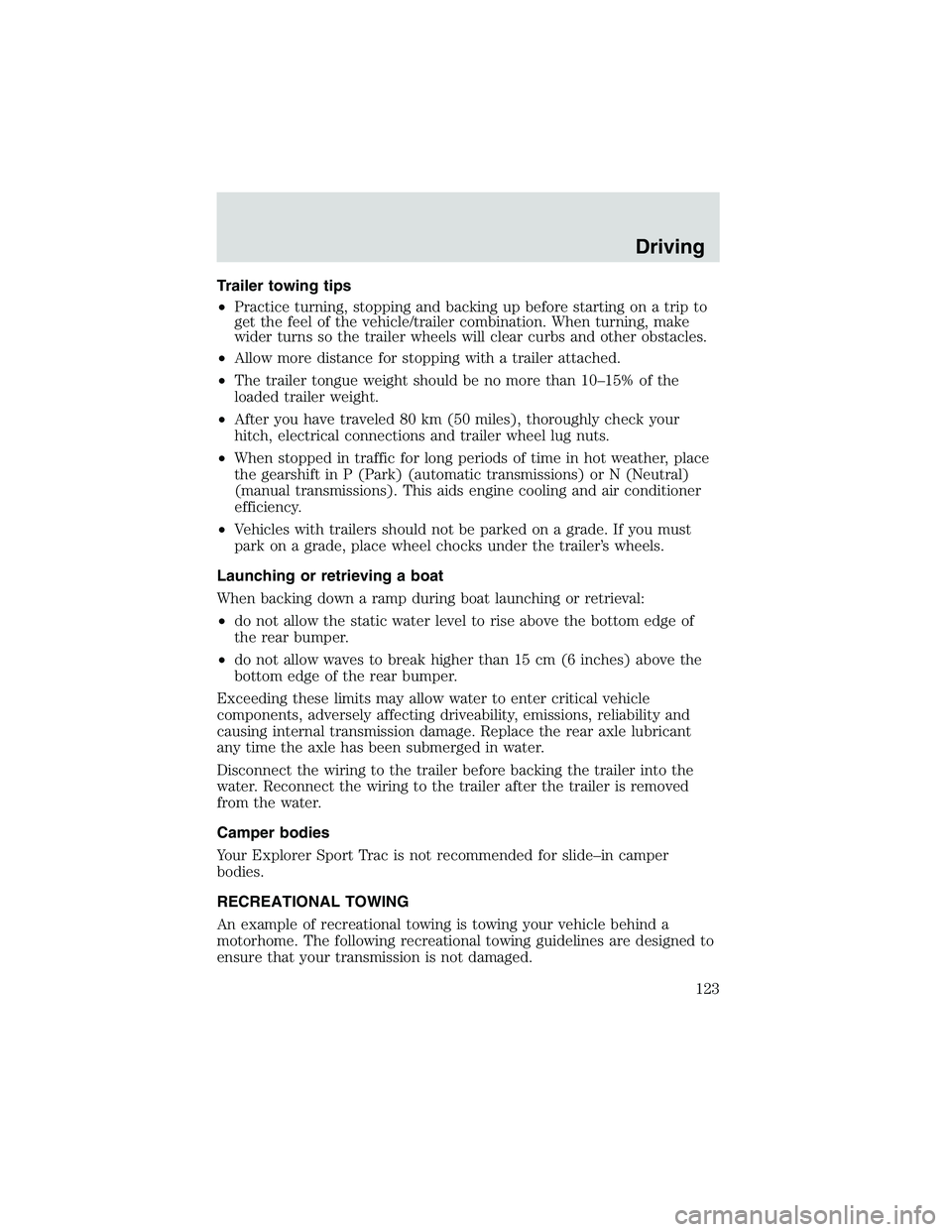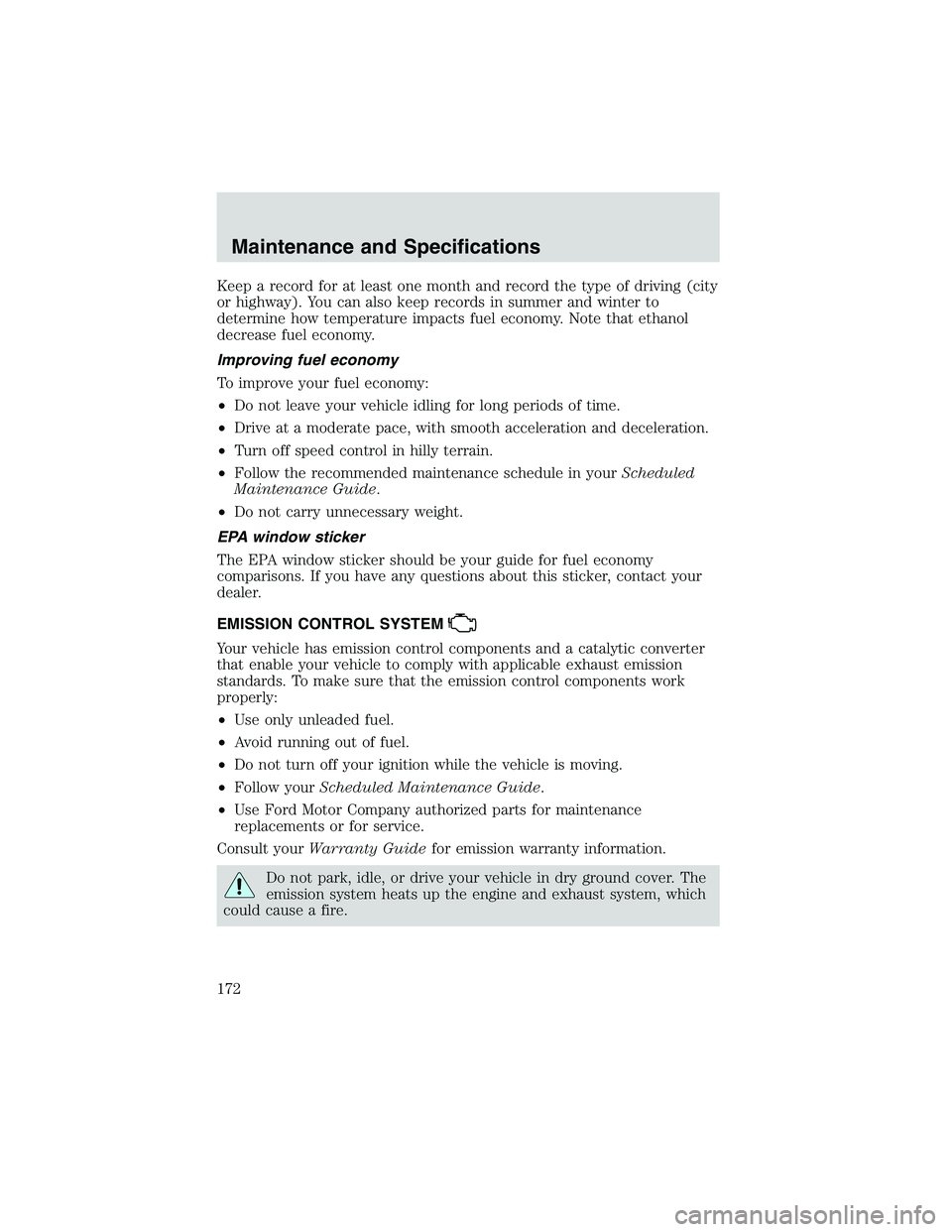Page 123 of 200

Trailer towing tips
•Practice turning, stopping and backing up before starting on a trip to
get the feel of the vehicle/trailer combination. When turning, make
wider turns so the trailer wheels will clear curbs and other obstacles.
•Allow more distance for stopping with a trailer attached.
•The trailer tongue weight should be no more than 10–15% of the
loaded trailer weight.
•After you have traveled 80 km (50 miles), thoroughly check your
hitch, electrical connections and trailer wheel lug nuts.
•When stopped in traffic for long periods of time in hot weather, place
the gearshift in P (Park) (automatic transmissions) or N (Neutral)
(manual transmissions). This aids engine cooling and air conditioner
efficiency.
•Vehicles with trailers should not be parked on a grade. If you must
park on a grade, place wheel chocks under the trailer’s wheels.
Launching or retrieving a boat
When backing down a ramp during boat launching or retrieval:
•do not allow the static water level to rise above the bottom edge of
the rear bumper.
•do not allow waves to break higher than 15 cm (6 inches) above the
bottom edge of the rear bumper.
Exceeding these limits may allow water to enter critical vehicle
components, adversely affecting driveability, emissions, reliability and
causing internal transmission damage. Replace the rear axle lubricant
any time the axle has been submerged in water.
Disconnect the wiring to the trailer before backing the trailer into the
water. Reconnect the wiring to the trailer after the trailer is removed
from the water.
Camper bodies
Your Explorer Sport Trac is not recommended for slide–in camper
bodies.
RECREATIONAL TOWING
An example of recreational towing is towing your vehicle behind a
motorhome. The following recreational towing guidelines are designed to
ensure that your transmission is not damaged.
Driving
123
Page 172 of 200

Keep a record for at least one month and record the type of driving (city
or highway). You can also keep records in summer and winter to
determine how temperature impacts fuel economy. Note that ethanol
decrease fuel economy.
Improving fuel economy
To improve your fuel economy:
•Do not leave your vehicle idling for long periods of time.
•Drive at a moderate pace, with smooth acceleration and deceleration.
•Turn off speed control in hilly terrain.
•Follow the recommended maintenance schedule in yourScheduled
Maintenance Guide.
•Do not carry unnecessary weight.
EPA window sticker
The EPA window sticker should be your guide for fuel economy
comparisons. If you have any questions about this sticker, contact your
dealer.
EMISSION CONTROL SYSTEM
Your vehicle has emission control components and a catalytic converter
that enable your vehicle to comply with applicable exhaust emission
standards. To make sure that the emission control components work
properly:
•Use only unleaded fuel.
•Avoid running out of fuel.
•Do not turn off your ignition while the vehicle is moving.
•Follow yourScheduled Maintenance Guide.
•Use Ford Motor Company authorized parts for maintenance
replacements or for service.
Consult yourWarranty Guidefor emission warranty information.
Do not park, idle, or drive your vehicle in dry ground cover. The
emission system heats up the engine and exhaust system, which
could cause a fire.
Maintenance and Specifications
172
Page 193 of 200

Rear air deflector
Running bars
Skid plate
Tow hooks (front)
Universal floor mats, carpeted
For maximum vehicle performance, keep the following information in
mind when adding accessories or equipment to your vehicle:
•When adding accessories, equipment, passengers and luggage to your
vehicle, do not exceed the total weight capacity of the vehicle or of
the front or rear axle (GVWR or GAWR as indicated on the Safety
compliance certification label). Consult your dealer for specific weight
information.
•The Federal Communications Commission (FCC) and Canadian Radio
Telecommunications Commission (CRTC) regulate the use of mobile
communications systems - such as two-way radios, telephones and
theft alarms - that are equipped with radio transmitters. Any such
equipment installed in your vehicle should comply with FCC or CRTC
regulations and should be installed only by a qualified service
technician.
•Mobile communications systems may harm the operation of your
vehicle, particularly if they are not properly designed for automotive
use or are not properly installed. When operated, such systems may
cause the engine to stumble or stall or cause the transmission to be
damaged or operate improperly. In addition, such systems may be
damaged or their performance may be affected by operating your
vehicle. (Citizens band [CB] transceivers, garage door openers and
other transmitters with outputs of five watts or less will not ordinarily
affect your vehicle’s operation.)
•Ford cannot assume responsibility for any adverse effects or damage
that may result from the use of such equipment.
Accessories
193
Page 195 of 200

Ford accessories for your
vehicle .....................................157
Ford Extended Service
Plan ..........................................146
Getting assistance outside the
U.S. and Canada .....................150
Getting roadside assistance ...125
Getting the service you
need .........................................144
Ordering additional owner’s
literature .................................151
The Dispute Settlement
Board .......................................147
Utilizing the
Mediation/Arbitration
Program ...................................150
D
Doors
lubricant specifications ..........186
Driving under special
conditions ..........................112, 114
sand .........................................113
snow and ice ...........................115
through water .........................116
E
Engine ........................................188
cleaning ...................................154
lubrication
specifications ..................186, 188
refill capacities ........................183
service points ..........................160
starting after a collision .........126
Engine block heater .................103
Engine oil
filter, specifications ................183
refill capacities ........................183
specifications ..................186, 188Exhaust fumes ..........................103
F
Floor mats ...................................54
Fluid capacities .........................183
Foglamps .....................................33
Four-Wheel Drive vehicles .......111
description ..............................111
driving off road .......................112
electronic shift ........................112
indicator light .........................111
preparing to drive your
vehicle .....................................105
Fuel
capacity ...................................183
filling your vehicle with fuel ..171
filter, specifications ................183
fuel pump shut-off switch .....126
octane rating ...........................188
G
Garage door opener ....................43
Gauges .........................................11
GAWR (Gross Axle Weight
Rating) .......................................116
calculating ...............................118
definition .................................116
driving with a heavy load ......116
location ....................................116
GVWR (Gross Vehicle Weight
Rating) .......................................116
calculating .......................116, 118
definition .................................116
driving with a heavy load ......116
location ....................................116
H
Head restraints ...........................73
Index
195